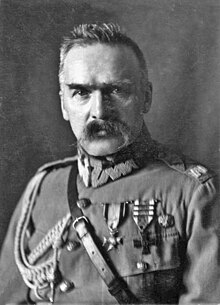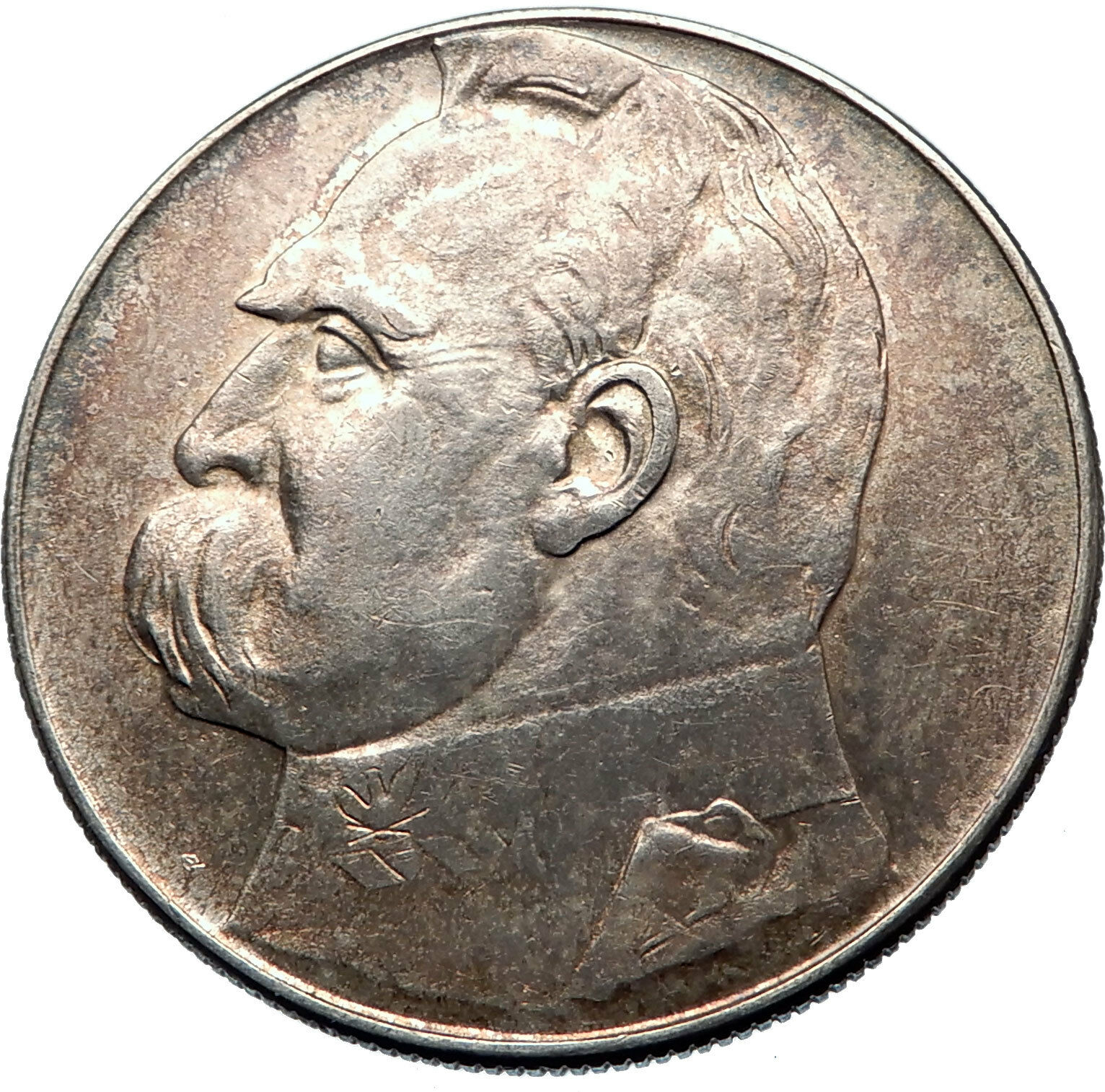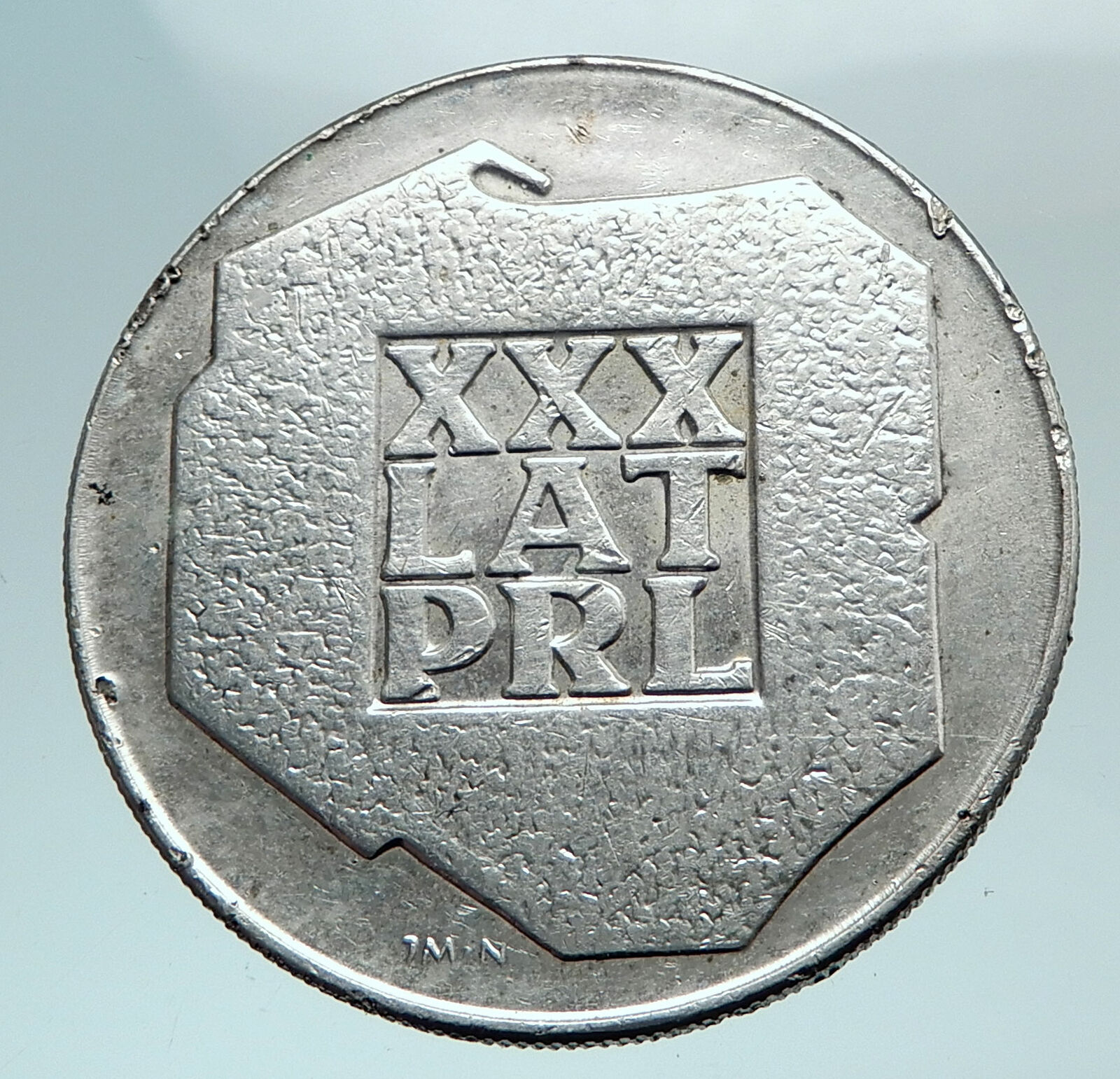|
Poland
1935 Silver 10 Zlotych 34mm (21.95 grams) 0.750 Silver (0.5305 oz. ASW)
Reference: KM# 29
RZECZPOSPOLITA POLSKA 10 ZŁOTYCH 10, Year.
Józef Piłsudski’s head left
You are bidding on the exact item pictured, provided with a Certificate of Authenticity and Lifetime Guarantee of Authenticity.
Józef Klemens Piłsudski (5 December 1867 – 12 May 1935) was a Polish statesman who served as the Chief of State (1918-22) and First Marshal of Poland (from 1920). He was considered the de facto leader (1926-35) of the Second Polish Republic as the Minister of Military Affairs. From World War I he had great power in Polish politics and was a distinguished figure on the international scene. He is viewed as a father of the Second Polish Republic re-established in 1918, 123 years after the 1795 Partitions of Poland by Austria, Prussia and Russia. Marshal of Poland (from 1920). He was considered the de facto leader (1926-35) of the Second Polish Republic as the Minister of Military Affairs. From World War I he had great power in Polish politics and was a distinguished figure on the international scene. He is viewed as a father of the Second Polish Republic re-established in 1918, 123 years after the 1795 Partitions of Poland by Austria, Prussia and Russia.
Deeming himself a descendant of the culture and traditions of the Polish-Lithuanian Commonwealth, Piłsudski believed in a multi-ethnic Poland-“a home of nations” including indigenous ethnic and religious minorities that he hoped would establish a robust union with the independent states of Lithuania and Ukraine. His principal political antagonist, Roman Dmowski, leader of the National Democrat party, by contrast, called for a Poland limited to the pre-Partitions Polish Crown and based mainly on a homogeneous ethnically Polish population and Roman Catholic identity.
Early in his political career, Piłsudski became a leader of the Polish Socialist Party. Concluding that Poland’s independence would have to be won militarily, he formed the Polish Legions. In 1914 he correctly predicted the outbreak of a major war, the Russian Empire’s defeat by the Central Powers, and the Central Powers’ defeat by the western Allies. When World War I began in 1914, Piłsudski’s Legions fought alongside Austria-Hungary against Russia. In 1917, with Imperalist Russia faring poorly in the war, he withdrew his support for the Central Powers and was imprisoned in Magdeburg by the Germans.
From November 1918, when Poland regained its independence, until 1922, Piłsudski was Poland’s Chief of State. In 1919-21 he commanded Polish forces in six border wars that re-defined the country’s borders. His forces seemed on the verge of defeat in the Polish-Soviet War when, in the August 1920 Battle of Warsaw, they threw back the invading Soviet Russian forces. In 1923, with the government dominated by his opponents, in particular the National Democrats, Piłsudski retired from active politics. Three years later he returned to power in the May 1926 coup d’état and became Poland’s strongman. From then on until his death in 1935, he concerned himself primarily with military and foreign affairs.
In international affairs, Piłsudski pursued two complementary strategies meant to secure Poland’s independence and to enhance her national security: “Prometheism”, aimed at achieving the disintegration of Imperialist Russia and later the Soviet Union into their constituent nations; and the creation of an Intermarium federation of Central and Eastern European states lying between the Baltic and Black Seas; serving as a bridge between Germany and Russia. The proposed Intermarium’s central purpose was to secure its peoples against Western and Eastern European imperialisms.
Historian Piotr Wandycz characterizes Piłsudski as “an ardent Polish patriot who on occasion would castigate the Poles for their stupidity, cowardice, or servility. He described himself as a Polish-Lithuanian, and was stubborn and reserved, loath to show his emotions.” Though some aspects of Piłsudski’s administration remain controversial, he is highly esteemed in Polish memory and is regarded, together with his chief antagonist Roman Dmowski, as a founder of the modern independent Poland.

 Poland, officially the Republic of Poland, is a country in Central Europe, bordered by Germany to the west; the Czech Republic and Slovakia to the south; Ukraine and Belarus to the east; and the Baltic Sea, Kaliningrad Oblast (a Russian exclave) and Lithuania to the north. The total area of Poland is 312,679 square kilometres (120,726 sq mi), making it the 69th largest country in the world and the 9th largest in Europe. With a population of over 38.5 million people, Poland is the 34th most populous country in the world, the 8th most populous country in Europe and the sixth most populous member of the European Union, as well as the most populous post-communist member of the European Union. Poland is a unitary state divided into 16 administrative subdivisions. Poland, officially the Republic of Poland, is a country in Central Europe, bordered by Germany to the west; the Czech Republic and Slovakia to the south; Ukraine and Belarus to the east; and the Baltic Sea, Kaliningrad Oblast (a Russian exclave) and Lithuania to the north. The total area of Poland is 312,679 square kilometres (120,726 sq mi), making it the 69th largest country in the world and the 9th largest in Europe. With a population of over 38.5 million people, Poland is the 34th most populous country in the world, the 8th most populous country in Europe and the sixth most populous member of the European Union, as well as the most populous post-communist member of the European Union. Poland is a unitary state divided into 16 administrative subdivisions.
The establishment of a Polish state can be traced back to 966, when Mieszko I, ruler of a territory roughly coextensive with that of present-day Poland, converted to Christianity. The Kingdom of Poland was founded in 1025, and in 1569 it cemented a longstanding political association with the Grand Duchy of Lithuania by signing the Union of Lublin. This union formed the Polish-Lithuanian Commonwealth, one of the largest and most populous countries of 16th and 17th-century Europe. The Commonwealth ceased to exist in the years 1772-1795, when its territory was partitioned among Prussia, the Russian Empire, and Austria. Poland regained its independence (as the Second Polish Republic) at the end of World War I, in 1918.
In September 1939, World War II started with the invasions of Poland by Nazi Germany and the Soviet Union (as part of the Molotov-Ribbentrop Pact). More than six million Polish citizens died in the war. In 1944, a Soviet-backed Polish Committee of National Liberation was formed which, after a falsified referendum in 1947 took control of the country and Poland became a satellite state of the Soviet Union, as People’s Republic of Poland. During the Revolutions of 1989 Poland’s Communist government was overthrown and Poland adopted a new constitution establishing itself as a democracy.
 Despite the large number of casualties and destruction the country experienced during World War II, Poland managed to preserve much of its cultural wealth. There are 14 heritage sites inscribed on the UNESCO World Heritage and 54 Historical Monuments and many objects of cultural heritage in Poland. Despite the large number of casualties and destruction the country experienced during World War II, Poland managed to preserve much of its cultural wealth. There are 14 heritage sites inscribed on the UNESCO World Heritage and 54 Historical Monuments and many objects of cultural heritage in Poland.
Since the beginning of the transition to a primarily market-based economy that took place in the early 1990s, Poland has achieved a “very high” ranking on the Human Development Index, as well as gradually improving economic freedom. Poland is a democratic country with an advanced high-income economy, a high quality of life and a very high standard of living. Moreover, the country is visited by nearly 16 million tourists every year (2013), which makes it one of the most visited countries in the world. Poland is the sixth largest economy in the European Union and among the fastest rising economic states in the world. The country is the sole member nation of the European Union to have escaped a decline in GDP and in recent years was able to “create probably the most varied GDP growth in its history” according to OANDA, a Canadian-based foreign exchange company. Furthermore, according to the Global Peace Index for 2014, Poland is one of the safest countries in the world to live in.
|





 Marshal of Poland (from 1920). He was considered the de facto leader (1926-35) of the Second Polish Republic as the Minister of Military Affairs. From World War I he had great power in Polish politics and was a distinguished figure on the international scene. He is viewed as a father of the Second Polish Republic re-established in 1918, 123 years after the 1795 Partitions of Poland by Austria, Prussia and Russia.
Marshal of Poland (from 1920). He was considered the de facto leader (1926-35) of the Second Polish Republic as the Minister of Military Affairs. From World War I he had great power in Polish politics and was a distinguished figure on the international scene. He is viewed as a father of the Second Polish Republic re-established in 1918, 123 years after the 1795 Partitions of Poland by Austria, Prussia and Russia. 
 Poland, officially the Republic of Poland, is a country in Central Europe, bordered by Germany to the west; the Czech Republic and Slovakia to the south; Ukraine and Belarus to the east; and the Baltic Sea, Kaliningrad Oblast (a Russian exclave) and Lithuania to the north. The total area of Poland is 312,679 square kilometres (120,726 sq mi), making it the 69th largest country in the world and the 9th largest in Europe. With a population of over 38.5 million people, Poland is the 34th most populous country in the world, the 8th most populous country in Europe and the sixth most populous member of the European Union, as well as the most populous post-communist member of the European Union. Poland is a unitary state divided into 16 administrative subdivisions.
Poland, officially the Republic of Poland, is a country in Central Europe, bordered by Germany to the west; the Czech Republic and Slovakia to the south; Ukraine and Belarus to the east; and the Baltic Sea, Kaliningrad Oblast (a Russian exclave) and Lithuania to the north. The total area of Poland is 312,679 square kilometres (120,726 sq mi), making it the 69th largest country in the world and the 9th largest in Europe. With a population of over 38.5 million people, Poland is the 34th most populous country in the world, the 8th most populous country in Europe and the sixth most populous member of the European Union, as well as the most populous post-communist member of the European Union. Poland is a unitary state divided into 16 administrative subdivisions. Despite the large number of casualties and destruction the country experienced during World War II, Poland managed to preserve much of its cultural wealth. There are 14 heritage sites inscribed on the UNESCO World Heritage and 54 Historical Monuments and many objects of cultural heritage in Poland.
Despite the large number of casualties and destruction the country experienced during World War II, Poland managed to preserve much of its cultural wealth. There are 14 heritage sites inscribed on the UNESCO World Heritage and 54 Historical Monuments and many objects of cultural heritage in Poland.




